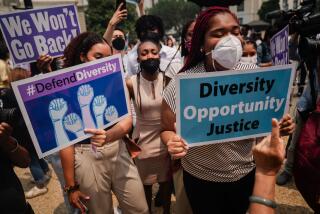Age Discrimination Can Be Fought, Older Workers Told
Miriam Geller was 55 and a teacher with 12 years of experience when she began a new job at a West Hartford, Conn., elementary school. After her second week on the job, Geller was replaced by a 27-year-old woman with three years’ experience.
School officials told Geller she never was officially hired. The school district had a policy of not employing new teachers with more than five years’ experience because their higher salaries made them too expensive.
“You’re a Cadillac; we can only afford a Buick,” the school principal told Geller.
Geller sued the West Hartford school system, charging that it had discriminated against her on the basis of age. In 1982 Geller won a landmark decision. The court ruled that it was illegal for the school system to have a hiring policy that in effect barred older workers from obtaining jobs.
“The school district didn’t overtly discriminate against older teachers because it didn’t say it wouldn’t hire somebody 50 or 60 years old,” attorney Raymond Fay said on Geller’s behalf during a partial re-enactment Wednesday night of her trial at the American Assn. of Retired Persons (AARP) convention in Anaheim.
“But the district’s practice of not hiring teachers . . . with more than five years’ experience had the discriminatory effect of preventing her from getting a job because of her age,” Fay told Los Angeles Superior Court Judge Richard A. Ibanez, who presided over the mock trial that was attended by an estimated 2,000 people. “The record in this case shows that 92.6% of teachers over 40 years old have more than five years’ experience.”
Geller and two other persons who have won trailblazing age-discrimination cases re-created their trial testimony during the session in an attempt to show other older workers how to recognize and fight age discrimination in employment.
The federal Age Discrimination in Employment Act prohibits employers from discriminating against people between the ages of 40 and 70 in employment, compensation or working conditions because of their age.
“Half the people protected by the act don’t understand it; thus, it is virtually impossible for them to pursue their rights under the law,” Fay told the audience in opening remarks. He is a noted Washington attorney specializing in age-discrimination cases.
The law requires that age-discrimination complaints first be filed with the federal Equal Employment Opportunity Commission (EEOC) in an effort to achieve out-of-court settlements.
“The complaints to the EEOC doubled between ’81 and ‘85, and the number of lawsuits have increased immensely,” Fay said. “However, the EEOC filed only 96 (court) cases in 1985 although it received 10,000 age-discrimination complaints.”
Thus, people increasingly are filing suits on their own. Fay said more individuals would do so if they were not deterred by the cost of suits. “It’s usually false that it’s too expensive to bring these suits on your own. You can act as your own attorney or find a lawyer to take your case at a modest fee.
“Or, if there is a companywide policy of age discrimination, you can band together with fellow workers and share the costs by bringing a class-action lawsuit,” Fay said. “Remember that if you win, your employer must pay your attorney’s fees.”
AARP executive director Cyril Brickfield told the gathering that ending age discrimination in employment was a high priority of the organization, which seeks to improve the lives and image of older people.
“More than 6 million of our 22 million members are in the work force,” Brickfield said. “That’s not too surprising, considering that anyone over 50 years old is eligible for AARP membership.
“But we also have a lot of members 60 and older who must work because of economic necessity. More importantly, older people have a right to work.”
Friend of the Court
Brickfield noted that in the past year the AARP had filed a dozen “friend of the court” briefs supporting the positions of people who had filed age-discrimination suits. Because of the AARP’s growing concern with what Brickfield said was “a national problem,” the organization for the first time plans to file its own age-discrimination suits in coming months.
In an interview, David Gamse, director of AARP’s worker equity department that handles age-discrimination problems, said that these would be class-action suits “to benefit thousands of people.” They are to be filed against several companies, but he declined to identify them.
“We’re bringing these suits because nobody else is doing so,” Gamse said. He added that not only were 6 million of AARP’s 22 million members working but also that a survey showed that half of the remainder--8 million people--would like to work part time. However, they are often prevented from doing so because of age discrimination, Gamse said.
Not Hired
The three people whose trials were featured at Wednesday’s session represented prevalent forms of age discrimination, AARP officials said. Geller was not hired because of her age.
Trial participant Eugene Goodman recounted that he was 49 and brought 25 years of marketing experience to Heublein Corp. in New York City when he joined the firm in 1972 on the promise that he would be promoted to vice president within a year. However, Goodman was repeatedly passed over for promotion. The four vice president positions that were filled during his five years with the company went to men in their 30s with less experience.
Though it took five years and consumed most of his money, Goodman successfully sued his employer for more than $500,000 after showing that Heublein had not promoted him as part of a campaign to convince Wall Street that the company was run by young, dynamic managers. In 1983 he wrote “All the Justice I Could Afford,” detailing the frustration and expense of this legal struggle.
Worked His Way Up
Philip Cancellier testified that he was 51 and during 25 years with the I. Magnin specialty store chain had worked his way up through the ranks to vice president of the company. He was fired in 1978 because his job was eliminated in a corporate reorganization at the firm’s San Francisco headquarters, he told Judge Ibanez.
Cancellier and two other I. Magnin executives in their 50s sued, claiming that they were let go because of a new push in the company to appeal to the youth clothing market by replacing longtime managers with younger personnel. In 1982 Cancellier and the two other terminated executives were awarded $2.3 million, which at the time was one of the largest age-discrimination awards ever won. Cancellier alone won $800,000.
The three-day gathering, which ended last night, was held at the Anaheim Convention Center. AARP officials said it attracted more than 25,000 people.
More to Read
Sign up for Essential California
The most important California stories and recommendations in your inbox every morning.
You may occasionally receive promotional content from the Los Angeles Times.










